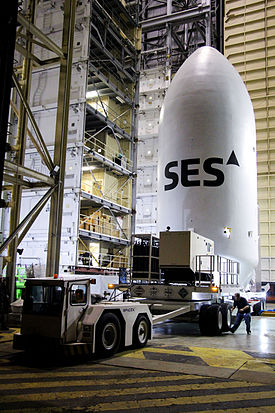SES-9
| SES-9 | |
|---|---|

|
|
| Start date | March 4, 2016 at 11:35 PM UTC |
| Launcher | Falcon 9 v1.2 |
| Launch site | CCAFS LC40 |
| COSPAR-ID : | 2016-013A |
| Takeoff mass | 5,271 kg |
| Empty mass | 2,835 kg |
| Span in orbit | 48 m |
| Manufacturer | Boeing |
| Satellite bus | BSS-702HP |
| lifespan | 15 years |
| Stabilization | Three-axis stabilization |
| operator | SES |
| Playback information | |
| Transponder | 57 Ku-band transponders |
| Others | |
| Electrical power | 12.7 kW |
| Power storage | two lithium-ion batteries |
| position | |
| First position | 108.2 ° East |
| List of geostationary satellites | |
SES-9 is a commercial communications satellite operated by satellite operator SES World Skies .
mission
It was on March 4, 2016, a Falcon 9 - carrier rocket from the rocket launch site Cape Canaveral in a slightly super synchronous geostationary transfer orbit brought. The target orbit had a perigee of 290 km, an apogee of 40,600 km and an inclination of 28 °. On this mission of the Falcon 9 the programming of the upper level was changed. Instead of going to a certain orbit, the engine of the upper stage continued to burn until the fuel was used up. In this way, the burning time of the upper stage is extended by a few seconds, resulting in a significant increase in the top speed and also in the payload capacity, and the apogee increases from 26,000 km to 40,600 km. The satellite was separated from the upper level 31 minutes after take-off. During this take-off, a landing attempt on the lake platform with the name “Of course I still love you”, or OCISLY for short, was carried out. For this purpose, the first stage of the Falcon 9 flew a series of maneuvers after the stage separation, which brought it on a landing course on the lake platform. Due to the high performance requirements, the final burn process for landing on the drone ship was carried out with three engines, which leads to a short, strong deceleration. The rocket made it to the lake platform, but the final approach did not succeed. The launch of the rocket was actually planned for February 24, but postponed several times due to various problems with refueling the rocket.
construction
The three-axis stabilized satellite with 57 Ku-band - transponders equipped and is on the position of 108.2 degrees East, together with SES-7 supply Northeast Asia, South Asia and Indonesia with television and communications services and allow maritime communications for ships in the Indian Ocean. It was based on the satellite bus BSS 702HP of Boeing built and has a design life of 15 years. The contract to build the satellite was signed in October 2012.
Web links
Individual evidence
- ↑ a b c ses.com: SES-9 - SES.com ( memento of March 6, 2016 in the Internet Archive ), accessed on March 9, 2016
- ↑ Spaceflight 101: SES-9 Satellite - Falcon 9 - SES-9 , accessed March 9, 2016
- ↑ a b raumfahrer.net: SpaceX launches SES-9 , author: Tobias Willerding from March 5, 2016, 1:41 am, accessed on March 9, 2016
- ↑ spacex.com: SES-9 Mission , accessed March 9, 2016
- ↑ SpaceNews.com: SpaceX scrubs SES-9 launch again , accessed March 9, 2016
- ↑ satbeams.com: SatBeams - Satellite Details - SES 9 , accessed March 9, 2016
- ↑ mediaroom.com: Boeing: Boeing to Build 702HP Communications Satellite for SES , accessed on March 9, 2016